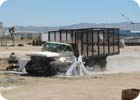Headaches in Parking Lots, Garages

Parking lots and parking garages provide a unique set of problems when considering access control. There are many solutions to the many problems that parking lots and parking garages present. The first question when approaching any access control problem is simple: What are you trying to accomplish? What access are we trying to control? Certainly we are trying to control cars, but are we also trying to control pedestrians?
Vehicles are large, and can be controlled with something as simple as a gate arm. Pedestrians are a whole different approach and can easily squeeze around gate arms, while roll up doors (or something similar) are required to keep people/pedestrians out. Your needs determine your approach.

Take a rearview mirror approach to parking lot and garage security. Vehicles are large, and can be controlled with something as simple as a gate arm. But your security needs determine your approach.
IN AND OUT
The approach is two phase, first, what physically keeps vehicles out? A gate arm? A roll-up door? Second, what lets vehicles in? An access card? A keypad? A transponder? All have pros and cons.An access card is a good option. A “unique possession,” the advantage is that a person is required to possess the card to gain access. The disadvantage is that anyone who possesses the card can get access. Cards can be lost or stolen. While there is a corporate mentality to put a corporate logo on everything, this is one circumstance in which it is better to leave the card blank, so that if it is lost or stolen, the finder (if lost) or thief (if stolen) wouldn’t know where to use the card. In order to open the door, the card has to be presented to a reader installed close to the door.
The keypad approach is common in places like apartments and condos. Again, pros and cons. There is no card to lose or to get stolen, only a “code” to be keyed in. The biggest problem is that the code can be shared. Sharing a code creates more problems (problems always seem to multiply!)…once you give your code to someone else to use, you cannot take it back, and worse, you cannot control to whom they give it. Often condo and apartment codes are widely known and shared by taxi drivers and pizza delivery drivers.
A third option is an RFID unit attached (usually with Velcro) to the vehicle. This type of system identifies the vehicle, and automatically opens the gate or door. RF based systems demand careful adjustment. It is not uncommon for the RF unit in the second or third car in a line to open the gate for the first car, even if the first car isn’t authorized access. The advantage is that it is “hands free” and user friendly, requiring minimum interaction with the driver.
Clarify your needs, pick you best option, and lock down your garage.

High security beam barriers must meet crash test requirements. In certain parking lot and garage situations, barriers are a good bet to protect the perimeter.
SIDEBAR: Want to Stop a 15,000 Pound Truck Going 50 mph?
Grab a hold of a beam barrier. Delta Scientific, for example, just introduced a 12- to 30-foot wide beam barricade. In its first crash test, the 725-pound beam of the vertical lift barricade stopped a 15,000-pound vehicle traveling 50 mph dead in its tracks, equivalent to 1.2-million foot-pounds of kinetic energy. By doing so, it meets the K12 crash certification standard set by the United States Department of State.Such beam barricades are available in hydraulic and manually operated models. Models are crash rated with one version enhanced for applications at nuclear power plants.
Looking for a reprint of this article?
From high-res PDFs to custom plaques, order your copy today!




